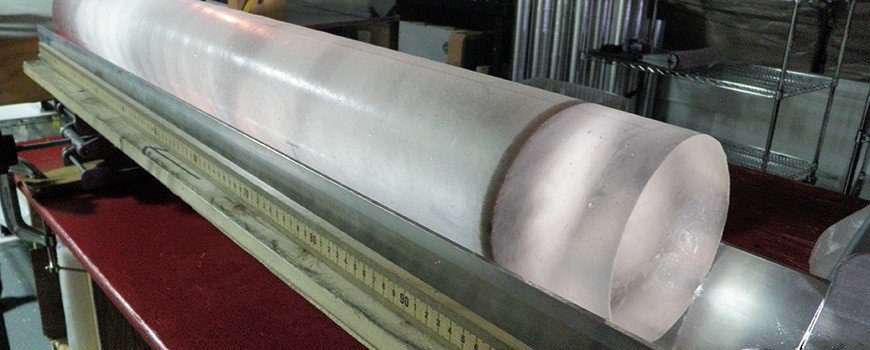A new highly detailed ice core from West Antarctica has revealed a consistent pattern of climate changes that started in the Arctic and spread across the globe to the Antarctic during planet Earth’s last glacial period.
Data extracted from this extraordinary ice core represents more than 68,000 years of climate history and is helping scientists understand past, rapid climate fluctuations between warm and cool periods that are known as Dansgaard-Oeschger events.
The new study co-authored by Scripps Institution of Oceanography, UC San Diego, Professor of Geosciences Jeff Severinghaus illustrates how sudden climate changes that began in the North Atlantic around Greenland propagated southward, appearing in the Antarctic approximately 200 years later. Further, the new findings show how ocean currents were largely responsible for redistributing the heat between the Northern and Southern hemispheres in a process called the “bipolar seesaw.”
The National Science Foundation-funded study is published today in the journal Nature.
The ice containing the data was collected from the West Antarctic Ice Sheet (WAIS), and is known as the WAIS Divide ice core. The ice core contains uniquely detailed information on past environmental conditions such as the atmospheric concentration of greenhouse gases, surface air temperature, wind patterns, and the average temperature of the ocean.
“Our finding that abrupt climate change began in the north and came some 200 years later in the south is good news for the future,” said Severinghaus. “This finding confirms the view that the abrupt changes were due to changes in North Atlantic currents, and we know that these currents are unlikely to shift in coming centuries.”
“Science has progressed in the past two decades,” Severinghaus added. “Whereas there was concern two decades ago about a possible shutdown of the North Atlantic circulation due to human activities, it is now clear that this will not happen, due to a previously unknown salt-driven stabilization of the sinking of dense water in the North Atlantic. While there are ample reasons to limit our emissions of greenhouse gases, a collapse of the North Atlantic circulation is not one of them. We can now at least take one of those potential ‘tipping points’ off the list.”
A team of hydro-geologists based at the Desert Research Institute (DRI) in Reno, Nev. used their unique ice-core analytical system to measure impurities associated with sea salts and desert dust in more than two kilometers (1.6 miles) of the WAIS Divide ice core in support of this research.
Many of the methane measurements used in this study were measured by Oregon State University researchers also working in DRI’s ice core laboratory. The past temperatures were determined by measuring the isotopes of the melted ice at the University of Washington.
The Dansgaard-Oeschger events are the name given to warm periods in Greenland that lasted a few thousand years. The transition into and out of these warm periods occurred in less than 20 years, much faster than anything experienced in the last 10,000 years. Temperature changes in Antarctica followed an opposite pattern, with Antarctica cooling when Greenland was warm, and vice versa.
“These past climate changes are different from what is happening today,” said the study’s lead author Christo Buizert, a postdoctoral researcher at Oregon State University. “The abrupt climate changes during the ice age were regional in scope and caused by large-scale changes in ocean circulation. The changes in temperature and precipitation that are occurring now are global and primarily caused by increasing levels of carbon dioxide in the Earth’s atmosphere.”
However, Buizert explained, these new observations can be used to test and improve the global climate models that are used to predict future warming.
The research team, consisting of 28 science and engineering groups from around the United States, considered sites all over Antarctica before selecting the WAIS Divide site with the best combination of thick ice (3,405 meters or 11,200 feet), simple ice flow, and the optimal amount of annual snowfall around 40 centimeters (1.5 feet).
Previously drilled ice core records from Greenland had provided the detailed history of Arctic temperature change. The new WAIS Divide core data provide the Antarctic record required to make a detailed comparison.
The 12.2-centimeter (4.8-inch)-diameter cylinders of ice that make up the 3,405-meter (11,200-foot) long ice core were recovered at a field camp in the center of West Antarctica, 1,040 kilometers (650 miles) from the geographic South Pole.
Researchers from Oregon State University determined the relative timing of past, sudden climate changes between the Arctic and Antarctic using variations in the atmospheric concentration of methane, water isotopes, and sea salt concentrations in the Greenland and Antarctic ice cores.
An engineering team from the University of Wisconsin-Madison designed the ice coring drill and recovered the ice core.
DRI, along with the University of New Hampshire, coordinated the science, drilling, and logistics activities. The National Ice Core Laboratory in Colorado led the sampling and archiving of the ice core.

